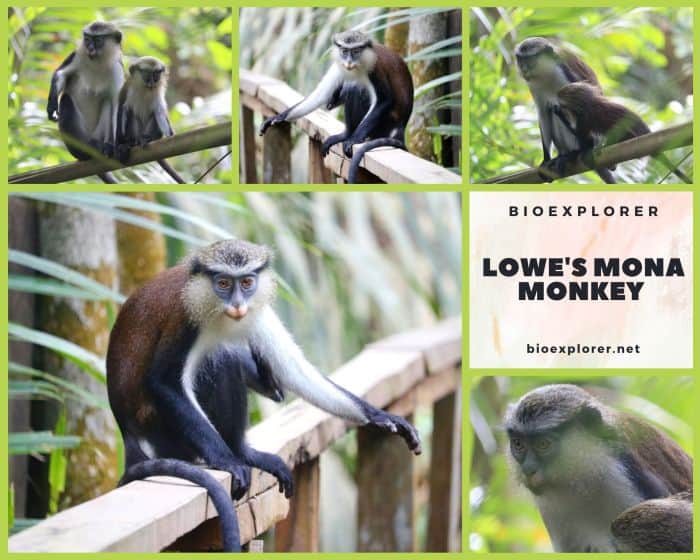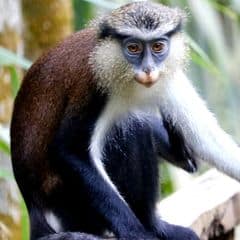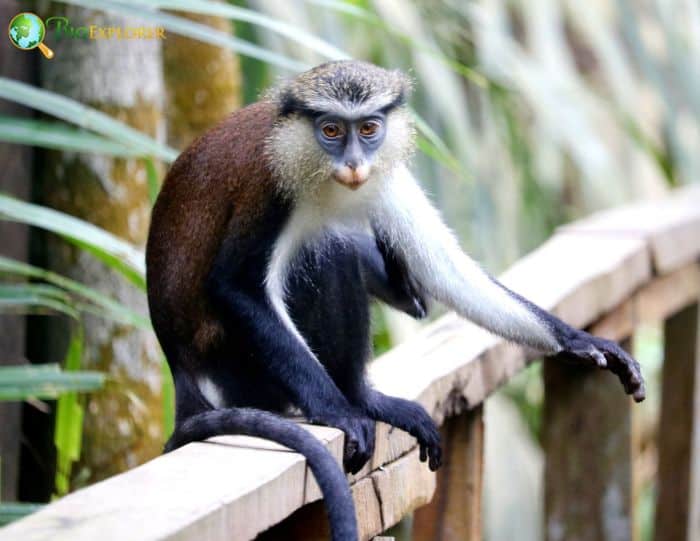
| Animalia | Primates | Cercopithecidae | Cercopithecus | Cercopithecus lowei |


- Common Name: Lowe’s Mona Monkey
- Taxonomy Classification Year: 1923
- Monkey Size: 41 to 63 (16 to 25 in)
- Skin Color(s): Brownish-yellow
- Habitat: Forest, rainforest, scrub forest
- Diet: Herbivorous
- Native Countries: Ghana, Ivory Coast
Lowe’s Mona Monkey Distribution
Lowe’s Mona Monkey Characteristics

Lowe’s Mona monkey[1] (Cercopithecus lowei) is an Old-World monkey in the Cercopithecidae family found from Ghana to the Ivory Coast.
- It was previously classified as a subspecies of Campbell’s mona monkey, Cercopithecus campbelli.
- Lowe’s Mona monkeys have interesting coloration with black or gray arms, legs, lower back, a brownish-yellow upper back, and a large, puffy, white ruff on the chest.
- The upper half of their face is yellow, and the sides are grey. The center of their face is bald and primarily grey, with pink under their nose.
- Their amber eyes are large and expressive. They have long, thin, black tail that helps them move through the forest.
- There is no sexual dimorphism apart from the larger size of the males.
What Do Lowe’s Mona Monkeys Eat?
The Lowe’s Mona Monkey consumes many plant matters including[¶]:
- Raphia Palm (Raphia africana).
- Leaf Flower (Phyllanthus)
- Persimmons (Diospyros)
- Fig (Ficus)
- Guanabanilla (Ouratea striata)
- Boleko Nut (Ongokea gore).
- Ohia (Celtis zenkeri)
- African Nutmeg (Pycnanthus angolensis).
- Chinalaurel (Antidesma)
- Chinese Banyan (Ficus thonningii).
- Hairy Rock Fig (Ficus glumosa).
- Sacred Garlic Pear (Crateva religiosa).
Lowe’s Mona Monkey Facts
- Lowe’s Mona monkeys generally consist of one male and several females. However, bachelor groups of males and groups with several males and several females have also been observed.
- Females within the group tend to be very social, with males interacting less frequently with other group members.
- Females, who make up the majority of adults in a group, have a much wider range of vocalizations than males, including types of calls to indicate distress, threat, and contact with another group.
- Around dawn and dusk, the dominant male will climb a post in an emerging tree and give a series of booms.
- Lowe’s Mona Monkey is a slow and deliberate collector.
Suggested Reading: All Different Types of Monkeys
Cite This Page
APA7MLA8Chicago
BioExplorer.net. (2025, January 02). Lowe’s Mona Monkey. Bio Explorer. https://www.bioexplorer.net/animals/mammals/monkeys/lowes-mona-monkey/.
BioExplorer.net. "Lowe’s Mona Monkey" Bio Explorer, 02 January 2025, https://www.bioexplorer.net/animals/mammals/monkeys/lowes-mona-monkey/.
BioExplorer.net. "Lowe’s Mona Monkey" Bio Explorer, January 02 2025. https://www.bioexplorer.net/animals/mammals/monkeys/lowes-mona-monkey/.
















